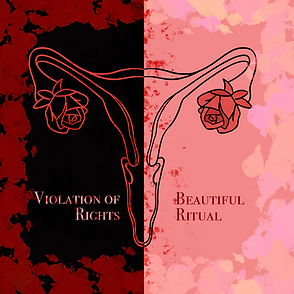DMEJ
Duke Medical Ethics Journal
The Culture Clash on Female Genital Mutilation
By: Raphael Lee
Edited by: Heiley Tai
It seems inconceivable that even in 2023, people are arguing that cutting a female’s genitalia should be allowed. However, there are global discussions going on currently about this matter. Female genital mutilation (FGM) is a procedure which the whole or part of a female’s genitalia is removed. Globally, there is an estimated 200 million females that have undergone FGM procedures. Most of these procedures are practiced in African and Asian countries. However, there are still a high number of females in the United States that are also affected by these practices. In recent years, there has been a push by organizations such as the WHO to eliminate FGM practices deeming that they breach human rights violations. On the other hand, many of the communities that practice these procedures believe that FGM is a critical aspect of their culture and arefighting to keep their culture intact.
Female genital mutilation is a broad term for a range of procedures that alter the female genitalia. There are currently four major classified types of FGM from type 1 to type 4 procedures. The figure below details the effects of each FGM procedure on the female genitalia. These procedures can lead to short term complications such as severe pain, infections, urinary problems and more. The procedures can also have more of a long lasting effect on the women like scarring, menstrual problems, increased risk of childbirth complications, and psychological problems.

Research also shows that even with all these risks, people are undergoing FGM when there are no medical benefits for having a FGM procedure. This has led many to question the validity of doing a procedure that could be dangerous without any benefits to the woman.
It is also worthy to note that many females that undergo FGM are underage girls. The United Nations has convened and published about the right of a child to be protected from harm as well as the right to live. Activists have argued that FGM procedures needs to be abolished to protect the young girls from experiencing these traumas. An interesting point of this argument is that male circumcision is legal and supported by the same organizations which are pushing to diminish FGM. Male circumcision does not have any medical benefits except for the weak research showing that it allows some protection for HIV. The WHO has kept pushing with governments to keep reducing the prevalence of FGM across the world. However, the WHO believe more involvement needs to be done by the international community in collaboration with the local community members to bring the prevalence down dramatically as FGM is a “harmful practice in violation with human rights”.
“It is a difficult path to find a solution that protects the fundamental rights of these women while respecting the deep cultures of the communities practicing FGM. We must keep having these discussions and compromise to build a better world.”
The practice of FGM on women goes back to traditions and cultures formed hundreds of years ago. While the reason varies in each community, a common reason for FGM procedures is that it represents a rite of passage for womanhood. Communities see this as an integral part to become a woman and consider uncircumcised girls unclean, promiscuous and immature until they undergo a procedure. This has led some women to be pressured to receive a FGM procedure to be accepted by the community.
The procedure is usually carried out by a woman in the community. This woman might be a family member or someone whose occupation is to assist in childbirth. They are not medical professionals and do not have the resources that a hospital might have, including sterile cutting devices, antibiotics, or anesthetics. After the procedure is completed, there are celebrations across the community as a girl has become a woman.
In the eyes of many Western countries, it is hard to imagine such a practice like FGM. However, many women in these communities do not share such feelings. An interview with a woman in the Maasai community spoke about how she wanted to get the procedure and would want it for her child as well. Other women in the community had shared thoughts with the woman in the interview showing that many women in communities don’t see FGM as the same way that Western countries see the procedures. They see the procedure as a step that a girl must take to become a woman.
There is a clear culture clash between these communities and western cultures. One culture sees a practice as a beautiful ritual that girls are eager to receive. A girl in a community in Kenya said, “I want to be circumcised… I am looking forward to becoming a woman.” On the other hand, it is seen as a violation of human rights. Joseph Osuigwe, founder of Devatop Centre for Africa Development, says, “To cut off the sensitive sexual organ of a girl is directly against the honesty of nature, a distortion to her womanhood, and an abuse of her fundamental human right”. When finding the best solution for this dilemma, it is important for people from different backgrounds to respect different cultures. The difficult aspect is how much value culture should have in affecting decisions such as the continuation of FGM. I believe there can be a path forward where we can work with these communities to help these women thrive in their culture while also protecting them from the harms and dangers of these practices. It is a difficult path to find a solution that protects the fundamental rights of these women while respecting the deep cultures of the communities practicing FGM. We must keep having these discussions and compromise to build a better world.


Review Editor: Heiley Tai
Design Editor: Olivia Fu
References
Althaus, F. A. (1997). Female circumcision: Rite of passage or violation of rights? International Family Planning Perspectives, 23(3), 130. doi:10.2307/2950769
Earp, B. (2016, May 06). Controversial views on "FGM". from https://blogs.bmj.com/medical-ethics/2016/02/02/controversial-views-on-fgm/
Female genital mutilation. (n.d.). from https://www.who.int/health-topics/female-genital-mutilation#tab=tab_2
Hernlund, Y., & Shell-Duncan, B. (2007). Transcultural bodies female genital cutting in global context. New Brunswick, NJ: Rutgers University Press.
Hoffman, B. (Producer), & Hoffman, B. (Director). (2014). Womanhood and circumcision: Three maasai women have their say (extended version, 2014). [Video/DVD] Berkeley, CA: Berkeley Media. Retrieved from https://search.alexanderstreet.com/view/work/bibliographic_entity%7Cvideo_work%7C3190435